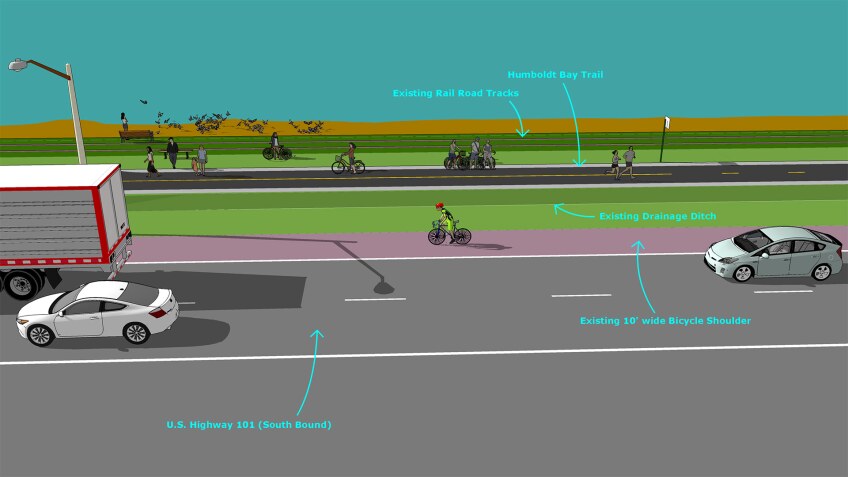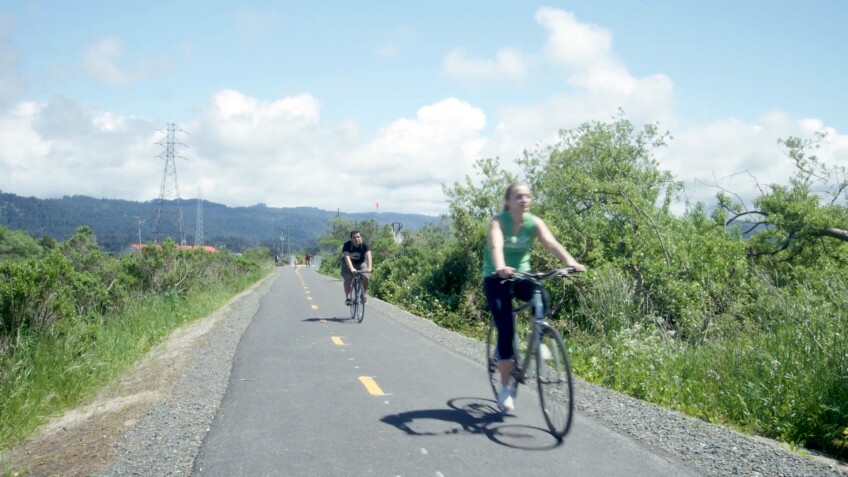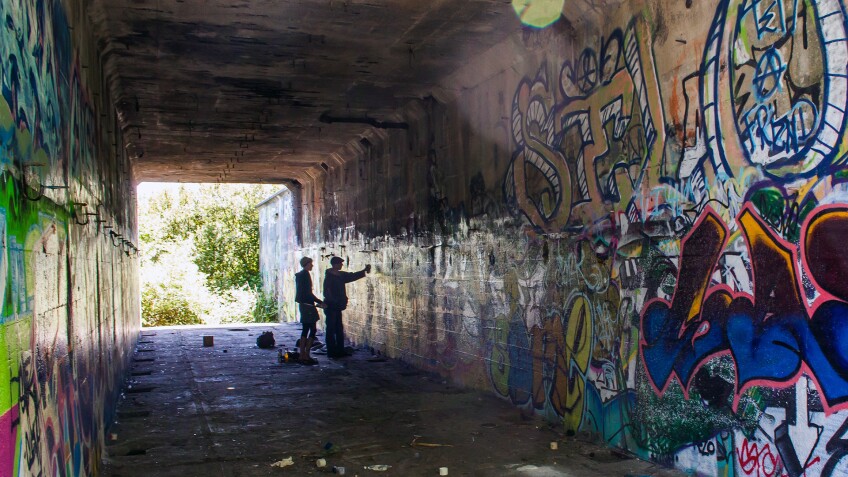Almost Complete, The Humboldt Bay Trail Realizes a Community's Dream

There is a tradition in Humboldt County and in the cities of Arcata and Eureka of active community involvement and fundraising for the 20-years-in-the-making Humboldt Bay Trail. From events such as a community dance party in Bayside to the annual Kevin Ebbert Run, Humboldt Bay Trail enthusiasts have been digging deep into their pockets to realize their dream.
That dream is an unbroken, 14-mile non-motorized, paved series of pathways that connect Arcata to Eureka. The two main portions of the Humboldt Bay Trail are complete and in daily use: the Eureka portion to the south, and the Arcata portion to the north, but connecting the two will be the crowning achievement of this project. Not surprisingly, the county of Humboldt has taken the lead in planning the construction of this four-mile missing piece between the cities, known as the “final four,” which is estimated to cost between $14 and $16 million dollars.
As of February 17, 2018, the Humboldt Bay Trail Fund, which is managed by the Humboldt Area Foundation and is the repository for the community’s generosity, raised $240,000 from several hundred donors made up of individuals and small businesses. These funds are to pay for not only ongoing maintenance of the Humboldt Bay Trail, but also to help fund the last four miles of trail that will connect the two cities. “I think this is really a fantastic example of what a generous community we have,” says Humboldt Area Foundation Executive Director Patrick Cleary. “They set a goal of raising $100,000 and they blew through that. It’s really been a remarkable show of community support.”
Completion of the final four cannot come too soon, for as it stands, cyclists — including the many citizens who commute to work between Arcata and Eureka by bike — must ride alongside freeway traffic, which is exactly what the completion of the Humboldt Bay Trail will mitigate.
Although full funding and thus construction of these final four miles may be years away, the longstanding engagement and commitment of this Northern California community by the bay is a priceless resource. Especially when one considers what it took to complete the existing parts of the trail.



“Multi-Use Trails Will Never Happen Here”
In the film, “Eureka Trailblazers: The True Story of the Eureka Waterfront Trail,” which was produced by the donation-funded Community Access Project for Eureka (CAPE), trail advocates talk of how many years it took to get the Humboldt Bay Trail project going. One of those trail advocates is Jen Rice, who, in her work with the Redwood Community Action Agency, participated in the trail’s conception in the mid-to-late 1990s and saw it through fallow times in the mid-aughts — until finally it started coming together.
Another trail advocate, Rick Littlefield, then-owner of Eureka Natural Foods grocery store, pointed out that at that time, the importance of trails had not yet been fully embraced by the collective. In fact, Rice recalls, city officials and other agencies back then were saying “multi-use trails will never happen here.”
But none of it discouraged Rice. On the contrary; she said her response was, “I think I just got my mandate…I just knew that it was nobody’s malicious intent to stop it necessarily; it’s just all the pieces weren’t quite in place.” Besides, she adds, it was hard for people to visualize a trail in what was basically at that time “kind of a muddy track.”
And then Eureka Community Services Director Miles Slattery came into city government. Slattery, Rice asserts, was the long-awaited champion that the project needed. Slattery and his team managed to get the first part of the Humboldt Bay Trail — known as the Hikshari’ Trail or Phase 1 — funded, designed, and constructed, and when it opened in March 2013, it was an instant success with the community. Finally, the erstwhile doubters could see the proof of what had been only a concept for all those years. And they were doubters no more.
Bruce Young, former Eureka Public Works Director, says, “Once Phase 1 was done, people could see the importance of the trail, how happy the citizens were…It changed the whole thought process toward the trail.”

Clearing the Devil's Playground
More from the California Coastal Trail
Although the thought process had changed, there were still more obstacles to overcome, especially the homeless encampments on the PalCo Marsh, a piece of land that is situated behind Eureka’s Bayshore Mall and which was earmarked for the trail. A small but significant group of residents in the encampments became so notorious for drug abuse, guns, theft and violence that the area they inhabited became known as the Devil’s Playground.
Crime was so rampant in the so-called Devil’s Playground that on a single day in April 2015, there were more than 20 arrests, including that of a man who had a “sawed-off rifle and body armor.”
Furthermore, the encampments had sanitation issues that affected not only the residents but the wetlands they inhabited. By 2014, the city of Eureka was doing weekly cleanups of the encampments, filling three to four 40-yard dumpsters with trash every week.
Pressure to shut down the encampment increased after a homeless woman who was camping on the marsh successfully sued the city of Eureka for injuries sustained by a fall in one of the concrete drying kilns on the property — a remnant of the days when the site was a mill. The encampment was seen not only as a safety hazard to its own residents and the nearby businesses that suffered from frequent theft, but also as a significant financial liability to the city.
On May 2, 2016, the city of Eureka finally carried out an eviction of these homeless encampments and the demolition of the graffitied concrete sheds which also provided shelter to some of the residents of the encampment.

Although the displacement of the homeless from these encampments posed a tragic loss for its inhabitants, most of whom were law-abiding citizens, the working poor who simply could not afford housing, and those with no other options, the community as a whole has not abandoned them. Resources for those displaced includes CAPE, which also serves Eureka’s homeless, low-income and foster youth populations.
There is also The Betty Kwan Chinn Homeless Foundation, whose namesake has been a longtime advocate of the homeless and whose dedication to the former PalCo Marsh encampment residents inspired her to create temporary housing known in the community as Betty’s Container Village. Made up of five shipping containers that house 40 homeless people and their pets for up to 90 days, the Village provides not only housing and three meals a day, but also case management services, a Learning Center to help people find jobs, health services, educational services, phone and mail services, identification papers services, and more.
Keeping the Trail Going
The citizens of Arcata, Eureka and Humboldt Counties continue to be passionate about their trails, whether it’s finding ever more creative ways to raise funds for the completion of the final four miles, or volunteering to pick up trash on the trail.
Volunteer stewardship of the trail, in fact, is a major part of the Humboldt Bay Trail’s success. Among other trail-advocacy activities, the all-volunteer, Arcata-based Humboldt Trails Council teams with the City of Arcata’s Environmental Services Department to host Community Volunteer Workdays in which volunteers clean up and maintain their beloved trails. The organization's summer 2018 newsletter reported an estimation of the contributions from Volunteer Trail Stewards (VTS) in 2017: "Over 665 volunteers of all ages and from all parts of our community contributed 2,646 hours of service." VTS volunteer Rees Hughes observes, "This is a testament to the way that people value local trails...and it makes a huge difference to understaffed city and county employees charged with maintaining local trails."

But the full weight of trail maintenance cannot be covered by volunteers alone, and the Humboldt Bay Trail Fund is hoping its success in exceeding its initial fundraising goal bodes well for the future. According to Eureka Community Services Director Miles Slattery, “the ultimate goal is to get it to a million.” That level of funding would include paying for three staff members — one from each of the cities of Eureka and Arcata and one from Humboldt County—who would each be assigned to maintaining their jurisdiction’s part of the trail."
Community fundraising is likely to continue for some time. “We’ll take donations as long as people want,” Humboldt Area Foundation Executive Director Patrick Cleary says, keeping the dream of a united trail alive for years to come.
Top Image: Elk River Slough Foot Bridge, Eureka | Humboldt Baykeeper/Flickr



